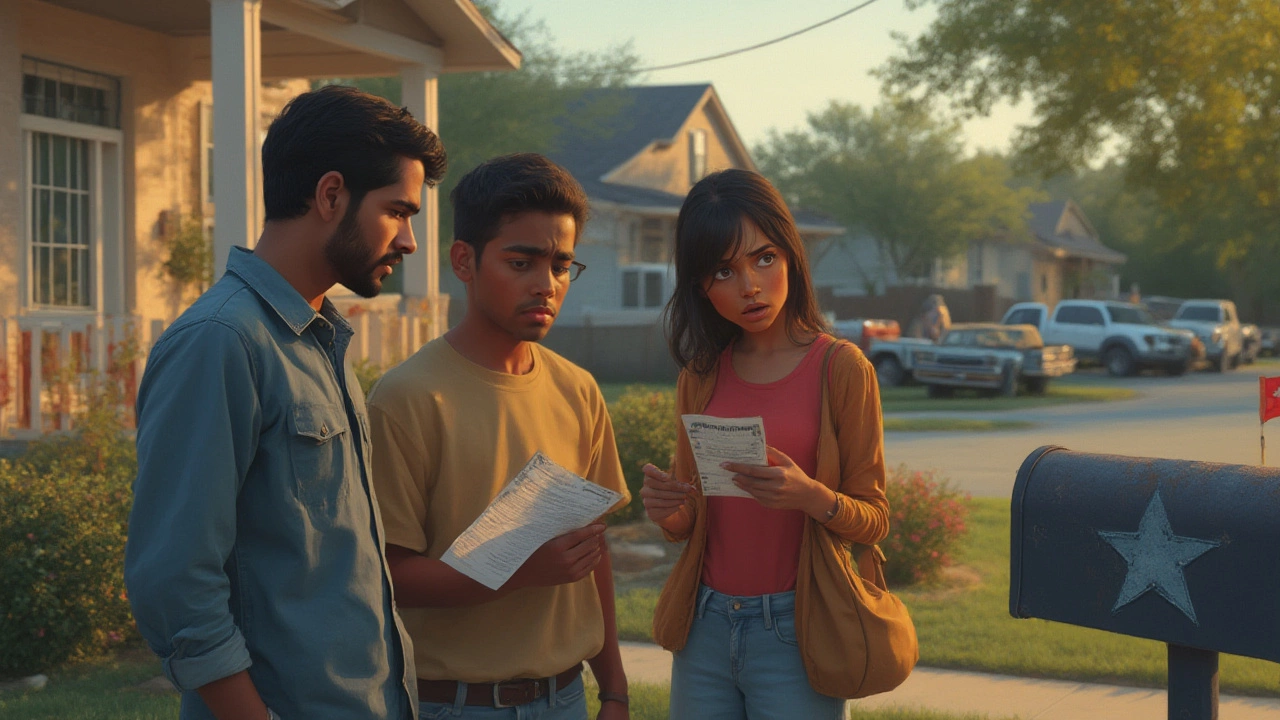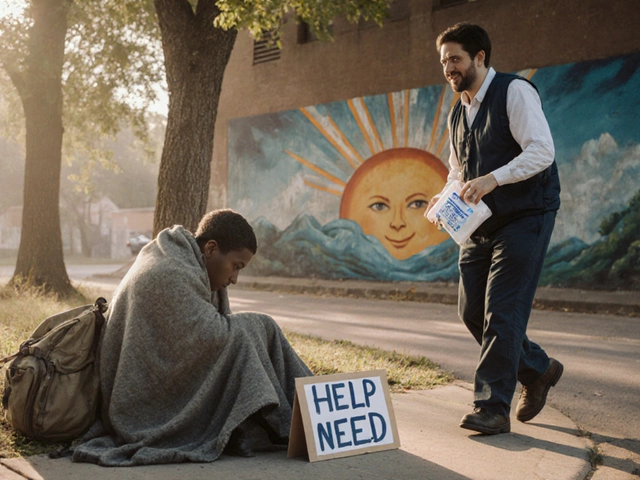Think you know what it means to be "poor" in Texas? Try looking past the stereotypes of big trucks and even bigger steaks. Behind that wide Texas sky, thousands of families are quietly struggling to make rent, buy groceries, and keep the lights on. Numbers tossed around in news headlines rarely tell the whole story—and the line between just scraping by and outright poverty is thinner than you might expect.
Defining Poverty in Texas: Numbers and Real Life
If you ask the federal government, the poverty line for a single adult in Texas in 2025 hovers around $15,060 per year, set by the Department of Health and Human Services. For a family of four, it's officially $31,200. These figures sound harsh, but they miss a whole layer of people who aren't “technically” poor but still can't cover basics. The cold truth? Poverty line Texas standards rarely match up to what it actually costs to get by, especially in big cities like Houston, Dallas, or Austin where rents are soaring far above the state average.
The Texas minimum wage remains locked at $7.25 per hour in 2025. That's just $1,160 before taxes if you work 40 hours a week. Try stretching it across rent, food, gas, healthcare, and you’ll see why most people earning minimum wage are living somewhere between broke and worried sick. By the way, 14% of Texans are living below the federal poverty line in 2025. If you zoom in on single parents or certain rural counties, the numbers climb even higher. About one in five Texas kids lives in a household below the poverty line.
But there's a different kind of poverty too—the one that never shows up on official forms. The working poor in Texas are the ones who might make a little more than the cutoff, but their dollars don’t stretch far enough. The state’s median household income is around $72,000, but you only need to earn about $35,000 as a single adult to be above “low income” in most counties. If you’re in a big city, even $40,000 might leave you pinching pennies with nothing left at the end of each month.
People juggling two or three jobs, gig work, or the ever-popular side hustle are the norm. Texas is famous for its dynamism and “work hard” attitude, but don’t let the can-do spirit fool you. Life is tough for the millions living paycheck to paycheck. Food banks, charity organizations, and local churches see steady lines, especially after rent hikes and when unexpected medical bills hit—the most common reason Texans face bankruptcy, by the way.
So, what salary is considered poor in Texas? It’s complicated. Earning less than $15,060 is “official” poverty, but realistically, anything under $25,000 as a single adult or $50,000 for a family starts to feel dicey, especially if you want access to decent housing, healthcare, childcare, and maybe—even the odd meal out.
The Real Cost of Living: Beyond the Numbers
Let’s get real: the price tags for essentials in Texas keep creeping up, even as state leaders tout a ‘low cost of living’ compared to the rest of the U.S. While rural areas do see cheaper rents, big cities blow that myth out of the water. Houston's median rent for a one-bedroom sits at $1,330, Dallas isn’t far off, and Austin—famously ‘weird’—can run $1,800 or more for similar apartments. Wages, meanwhile, just haven’t caught up, and statewide wage growth has lagged behind rent increases for most of the 2020s.
Groceries are another weight on wallets. Texas may be big on beef and barbecue, but the grocery bill doesn’t care where you live. As of 2025, even a thrifty grocery budget for a family of four easily tops $800 a month. Add a couple of kids with food allergies or teenage appetites, and that number soars.
The car culture is impossible to dodge—literally. Public transit options are limited outside a few metro cores, so most Texans have to budget for gas, insurance, repairs, and car payments. Monthly transit costs typically run between $400-700, depending on commute length and car trouble. Healthcare is no picnic, either; Texas has the highest uninsured rate in America. Many working poor make too much for Medicaid but nowhere near enough to afford private plans. A single prescription or urgent care visit regularly derails household budgets.
Childcare is another jaw-dropper. The average Texas family with two young kids pays around $1,200 each month for daycare, a figure that’s up nearly 20% from just three years ago. With so many essentials climbing upward, income guidelines don’t come close to reality. Imagine trying to budget for a broken-down fridge or a sick day—most low-income families have no cushion for that.
Utilities, too, are notorious for seasonal spikes, especially during those sweltering Texas summers. Air conditioning isn’t what you’d call optional, and electric bills can briefly rival rent. Meanwhile, school supplies, internet, phone bills, and even occasional clothing purchases all pile on. This is why just scraping above the official poverty line often still means saying “no” to fun or emergencies.
If you want to get a sense for what’s left for “extras” like eating out or family trips—the answer is, not much. There’s also a social cost: people on the edge of poverty tend to skip routine medical and dental checkups, hold off on car repairs, and take on high-interest debt, which quickly snowballs. All of this adds up to a cycle of just-barely-getting-by that defines modern Texas poverty for way too many.

How People Cope and Where to Find Help
People get creative when their incomes fall short. Food banks are a huge part of the puzzle in Texas, with Feeding Texas reporting that 1 in 7 Texans relied on their network at least once in 2024. That’s more than 4 million people. During summer, free meal programs and city-run food distributions pick up the slack for kids no longer getting school lunches. Some families get monthly help from the Supplemental Nutrition Assistance Program (SNAP) or the Women, Infants, and Children program (WIC), but eligibility rules are strict and benefits rarely last the whole month.
Community Support organizations routinely step in to help with rent, utilities, transportation, and even job placement. Churches play a massive role in the Texas safety net, running clothing closets, volunteer-led food pantries, or offering small cash grants for emergencies. Then there are all those neighbors quietly lending a hand—sharing groceries, babysitting, or fixing cars for the cost of a coffee. It may not show up in the statistics, but this informal web ties entire communities together when money is short.
If you—or someone you know—is falling behind, here are a few practical tips:
- Always check for local rent or utility assistance before skipping a payment. Programs change by city but often have emergency funds for people at risk of losing their homes or power.
- Follow local Facebook groups or neighborhood Nextdoor pages—lots of real-time info on food distributions, free events, or pop-up clinics never makes the news or official sites.
- Get to know your local public library. They often host resume-building workshops, free tax assistance, and referrals for legal advice or government benefits.
- Contact schools—many have dedicated social workers who can help families connect to free or reduced lunch, after-school care, and low-cost internet programs.
- Look into Medicaid waivers if someone in the family is living with a disability or chronic illness. Waiting lists are long, but advocates can help speed up the process for urgent cases.
If your pride makes asking for help hard, remember—about half the state is just one paycheck away from financial trouble. Plenty of hard-working, responsible Texans are right there with you.
For those earning below Texas’s ‘survival’ salary and stuck in a never-ending cost shuffle, community resources can make the difference between despair and just barely hanging on. And lately, more grassroots groups are stepping up to fill the cracks when traditional aid falls short, running everything from free lunch events to mutual aid fundraisers for neighbors.
Looking Forward: The Changing Face of Poverty in Texas
Poverty in Texas isn’t static. In 2025, you’ll find struggling families not just in rural counties and border towns, but also tucked away in Houston suburbs or Austin’s outer limits, where rent spikes have forced working-class people further out. Even tech workers in Austin sometimes take on roommates to keep housing costs manageable. Meanwhile, inflation, unpredictable weather events, and a tough housing market all keep the pressure on.
Advocates are pushing for change: higher minimum wages, expanded Medicaid, and city zoning rules that create more affordable housing. But real progress feels slow. While some cities experiment with guaranteed-income pilot programs or increased funding for after-school programs and food access, the gaps are wide. And every time prices jump—whether due to drought, a housing crunch, or global shocks—another group risks sliding below a living wage.
But Texans are tough. More young people are turning to vocational training or trade schools, aiming for jobs like electricians or welders that pay better than retail or service gigs. Some older adults share multigenerational homes to combine incomes and childcare. Others join time banks—community groups that let people trade services instead of using cash.
Getting by on a “poor” salary in Texas may not make for glamorous headlines, but it’s the daily reality for millions. Understanding the real numbers—and the hidden stories they don’t always reveal—matters, because acknowledging the struggle is the first step toward making things better. Stay sharp and ask questions if you see neat stats that seem to tidy up messy realities. Poverty isn’t just about math—it's about real lives and real dreams left on hold.





